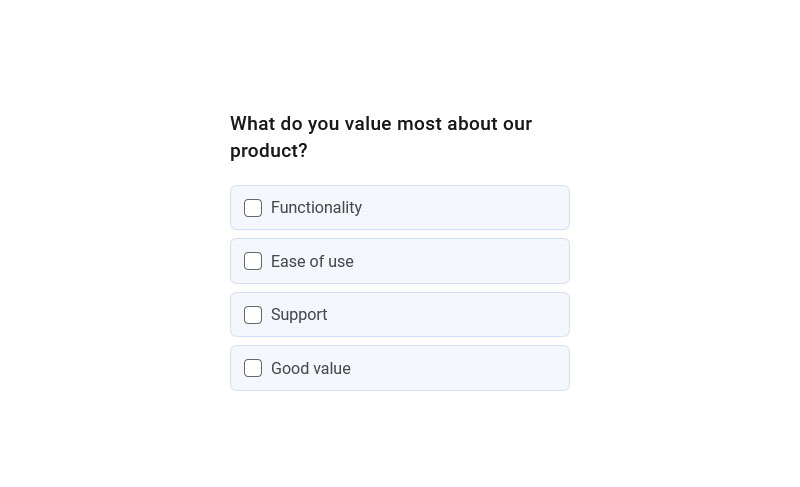
Hi everyone, my name is Neeraj Aneja and I am a UX researcher and e-commerce UX expert with over 10 years of experience. I have worked in different e-commerce industries with different clients and different user groups. Surveys are a great tool for quantitative research methods. It can help you gain insights into your brand or product. Today I’ll tell you how to conduct a survey and evaluate the results.
Surveys – Ask your users questions.
In surveys, we ask questions to users (customers, users or followers). First, you need to identify the motivation/KPI for your survey. Don’t waste your and your users’ time.
Ask yourself some questions.
– What is your motivation?
– Which survey would you like to conduct?
– What do you want to know?
– Do you want to solve the problem?
– Do you want to improve a feature?
– Do you want to solve the problem?
– Have you noticed anything that needs improvement?
Five “Why” Methods? (To find root-cause of any problem
This is a very simple technique that can help you dig deeper into the root causes behind a particular opinion or behavior. Ask why five times to find out the cause of the problem
For example,
Problem: Car won’t start.
1. Why can’t the car start?
Because the battery is dead.
2. Why is the battery dead?
Because the alternator is not charging.
3. Why doesn’t the generator charge the battery?
Because the alternator belt is broken.
4. Why did the generator belt break?
Because it’s old and wasn’t replaced during the last service.
5. Why was the alternator belt not replaced during the last maintenance?
Because there was no regular maintenance schedule in place.
The target group you want to target.
First, we must identify which target group we want to target. It can be big or small. Choosing the right size can be difficult. We sent the questionnaire to 10 users. It’s possible that not everyone will take your survey. If 7 people don’t respond, the conversion rate is 30%. The other extreme is if you have a large user base (say 500,000 users) and you decide to send a survey to all 500,000 people. There’s a good chance you’ll get good results from your survey.
Elements of survey.
High conversion rate
Homogeneous profile
How many answers contribute to better insights?
I recommend aiming for around the 100 best complete survey responses. 100 answers, where users answered all the questions.
Key Points for Conducting Surveys
- Create surveys that require minimal effort from users.
- Check, which question or section has a higher/lower conversion rate?
- At what point or question did users leave the survey? In this case, you need to change the question.
- Focus on the order of the questions. It can go from easy to difficult, or from difficult to easy.
- There are three types of Best trails: easy, medium and difficult.
- Survey time should be minimum duration, the shorter the better
- Let your potential participants know it will only take x minutes to complete your survey
- More time to fill survey reduces click-through rates.
Survey Preparation – Question Sequence
Start by building your questionnaire, always keeping your KPIs in mind. I want to assess the value of Instagram . In this example, our KPI could be user satisfaction, and we want to ensure that only users who have been registered on the platform for more than a year can participate in the survey.
TO know more about KPI’s visit
27 Examples of KPI’s
Sequencing of the Questions
Start with a difficult Question.
We start with very difficult questions that get easier as the investigation progresses. Such a survey design may cause many people to drop out. The first problem occurs because users consider the following questions to be as difficult as the first question and may be annoying to them.
Start with an easy Question.
We start with very simple questions like:
How old are you and what is your name?
questions that anyone can answer without thinking. And they type easily and often.
Next, we increase the difficulty a little, but not too hard, and look for real insights that are important to us but not too difficult. There are only a few questions left, we can ask the toughest questions.
Survey Tools
Survey Monkey and type form are the tools that you can use to conduct surveys.
Distribute the Survey / questionnaire.
- Writing an email is a good way to contact registered users.
- Social media offers very useful tools such as paid campaigns with configurable audiences.
- Use Facebook and Twitter to share your surveys.
- Add modals on your website.
- Hire a call center to conduct the survey. All you have to do is provide them with your question and a list of users’ phone numbers.
- Invite users and reward them for participating in surveys and Amazon coupons.
Evaluate the results.
- The survey results can be viewed on the software dashboard.
- The result data can be downloaded in Excel or CSV format.
- Check the number of users who clicked on the survey link, the number of users who started responding to the survey, and the number of users who completed the survey.
- Filter data by device.
- Which device has the most waste?
- If you find a question with a high drop rate, you should modify that question to fix it.
- Explore each dataset in detail
How to share your survey report?
Add a cover photo and logo, change colors and fonts. Add an introductory slide with your KPIs and research theme. View survey insights. Conduct brainstorming sessions with all stakeholders and iterate on the project.
Include these questions in your survey when investigating users on a Movie/Events Ticketing platform.
- To which age group do you belong?
- Can you provide your name?
- What is your gender?
- In which city are you situated?
- What is your occupation?
- Do you attend movies in theaters or events (post Covid)?
- How frequently do you utilize online platforms to book movie or event tickets?
- What is the reason behind your preference for booking movie or event tickets online?
- Which online platform do you use for purchasing tickets?
- On what devices do you primarily book movie or event tickets?
- What features do you consider essential during the ticket booking process?
- Have you encountered any challenges or difficulties while booking tickets online?
- Do you compare ticket prices on platforms other than your usual choice?
- If convenience fees were reduced, would you continue using your current booking platform?
- Would you remain loyal to your current booking platform if the cancellation options were enhanced?
- If more coupons or discounts were offered, would you continue using your current booking platform?
- Do you have any additional comments or suggestions for improving the overall online ticket booking experience?


